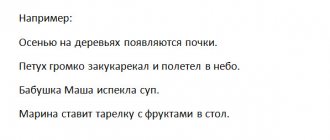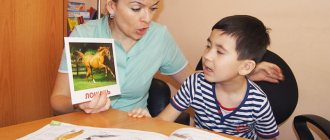Cheveleva's technique
A unique system of correctional work with stuttering preschoolers in the process of manual activity was proposed by N. A. Cheveleva. The author proceeds from the psychological concept that the development of a child’s coherent speech is carried out through a transition from situational speech (directly related to practical activities, with a visual situation) to contextual (generalized, associated with past events, with missing objects, with future actions), and then, throughout the preschool period, contextual and situational forms of speech coexist (S. L. Rubinshtein, A. M. Leushina). Therefore, the sequence of speech exercises with children who stutter is seen in a gradual transition from visual, facilitated forms of speech to abstract, contextual statements and includes the following forms: accompanying, final, preparatory.
The system of consistent complication of speech also provides for the gradual complication of objects of activity through an increase in the number of individual elements of work, into which the entire labor process in the manufacture of crafts is divided.
This system for overcoming stuttering in children includes 5 periods:
Propaedeutic. The main goal is to instill in children the skills of organized behavior, teach them to hear the laconic but logically clear speech of a speech therapist, its normal rhythm, and temporarily limit the speech of the children themselves.
Accompanying speech. During this period, children’s own speech is allowed regarding the actions they simultaneously perform. The greatest situationality of speech is provided by constant visual support. At the same time, it becomes more complicated due to the change in the nature of the speech therapist’s questions and the corresponding selection of crafts.
3 final speech - children describe work already completed or part of it. By regulating (gradually increasing) the intervals between the child’s activity and his response to what he has done, varying complexity of the final speech is achieved. With a gradual decrease in visual support for the work performed, a consistent transition to contextual speech occurs.
Pre-talk - children talk about what they intend to do. They develop the ability to use speech without visual support, plan their work, name and explain in advance the action that they still have to do. Phrasal speech becomes more complex: children pronounce several phrases related in meaning, use phrases of complex construction, and construct a story independently. During this period, they are taught to think logically, express their thoughts consistently and grammatically correctly, and use words in their exact meaning.
Strengthening independent speech skills involves children telling stories about the entire process of making a particular craft, their questions and answers about their activities, statements of their own free will, etc.
The method of N. A. Cheveleva implements the principle of successively complicating speech exercises in the process of manual activity based on one of the sections of the Program for raising and teaching children in kindergarten.
Mironova's technique
S. A. Mironova proposed a system for overcoming stuttering in preschoolers in the process of passing the program for the middle, senior and preparatory groups of kindergarten in the sections: Familiarization with the surrounding nature, Speech development, Development of elementary mathematical concepts, Drawing, modeling, application, design.
The author sets programmatic and correctional tasks for the speech therapist, which are solved during four stages (quarters) of progressively more complex correctional work.
When going through a mass kindergarten program with children who stutter, some changes are proposed that are related to the children’s speech abilities: using material from the previous age group at the beginning of the school year, rearranging some lesson topics, extending the time frame for studying more difficult topics, etc.
The correctional tasks of the first quarter consist of teaching the skills of using the simplest situational speech in all classes. Vocabulary work occupies a significant place: expanding the vocabulary, clarifying the meanings of words, activating passive vocabulary. The speech therapist himself is expected to be particularly demanding of the speech: the questions are specific, the speech consists of short, precise phrases in different versions, the story is accompanied by a demonstration, the pace is leisurely.
The correctional tasks of the second quarter consist of consolidating the skills of using situational speech, a gradual transition to elementary contextual speech, and learning to speak according to questions from a speech therapist and without questions. A large place is occupied by work on the phrase: a simple, common phrase, the construction of phrases, their grammatical design, the construction of complex sentences, the transition to composing a story. The sequence of studying program material is changing. If in the first quarter, in all classes, children are introduced to the same subjects, then in the second quarter, the subjects are not repeated, although objects are selected that are similar in terms of the general theme and purpose.
The correctional tasks of the third quarter consist of consolidating the skills of using previously learned forms of speech and mastering independent contextual speech. A significant place is devoted to work on composing stories: based on visual support, on questions from a speech therapist, and on an independent story. Children's practice in contextual speech increases. In the third quarter, the need for slow learning of the program, characteristic of the first stages of education, disappears, and classes approach the level of mass kindergarten.
The correctional tasks of the fourth quarter are aimed at strengthening the skills of using independent speech of varying complexity. Working on creative stories plays a big role. Along with this, the accumulation of vocabulary and the improvement of phrases begun at the previous stages of training continue. In speech, children rely on the questions of the speech therapist, on their own ideas, express judgments, and draw conclusions. Visual material is almost never used. The speech therapist’s questions relate to the process of the upcoming work, conceived by the children themselves. Corrective training is aimed at maintaining the logical sequence of the transmitted plot, at the ability to give additional explanations and clarifications.
The methods of N. A. Cheveleva and S. A. Mironova are based on teaching stuttering children to gradually master the skills of free speech: from its simplest situational form to contextual (the idea belongs to Prof. R. E. Levina). Only N.A. Cheveleva does this in the process of developing children’s manual activity, and S.A. Mironova does this when going through different sections of the kindergarten program. The very principle of the necessary combination of tasks of correctional and educational work with children who stutter should be considered correct and necessary in speech therapy practice.
Treatment of stuttering in children and adults (+DVD)
This is an excellent practical guide to using comprehensive techniques, programs and devices to eliminate stuttering. A description is given of both traditional, time-tested and highly effective methods of stuttering correction, as well as new methods that have appeared in recent years.
On sale here: www.labirint.ru/books/294599/
Video materials for these techniques are presented on the attached DVD. Also on the disk is the Zaikanie.NET program for the correction of stuttering and logoneurosis, offered free of charge to readers within the framework of a cooperation agreement between the UNESCO Institute of Information Technologies in Education and the Biocybernetics Research Center (Moscow). Using a personal computer, a microphone and headphones, you or your loved ones who have a stuttering problem, today, with the help of this program, you can get tangible benefits and begin to restore fluency of speech.
The book is intended for parents, high school students and students who are faced with the problem of stuttering. Undoubtedly, the publication is of interest to professionals: speech therapists, neurologists, students of medical and pedagogical universities.
See also the section: Speech development, speech therapy for preschoolers. There are other publications on stuttering correction.
Seliverstov's technique
V.I. Seliverstov’s method is primarily designed for working with children in medical institutions (in outpatient and inpatient settings) and involves the modification and simultaneous use of various (known and new) methods of speech therapy work with them. The author believes that the work of a speech therapist should always be creative and therefore, in each specific case, a different approach to children is necessary in finding the most effective methods for overcoming stuttering.
In the scheme proposed by the author for successively complicated speech therapy classes with children, 3 periods are distinguished (preparatory, training, consolidative), during which speech exercises become more complicated depending, on the one hand, on the degree of independence of speech, its preparedness, volume and rhythm, structure, and on the other hand the other depends on the varying complexity of speech situations: on the situation and social environment, on the types of activities of the child, during which his verbal communication occurs.
Depending on the level (threshold) of free speech and the characteristics of the manifestation of stuttering in each specific case, the tasks and forms of speech exercises differ for each child in the conditions of speech therapy work with a group of children.
A prerequisite for speech therapy classes is their connection with all sections of the Education and Training Program for children in kindergarten and, above all, with play as the main activity of a preschool child.







